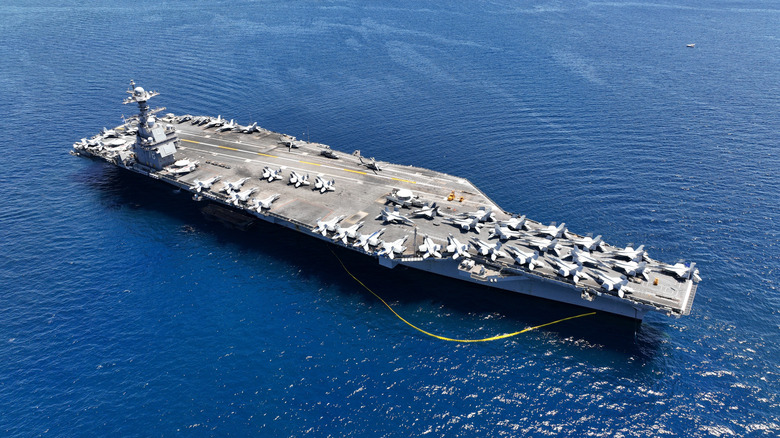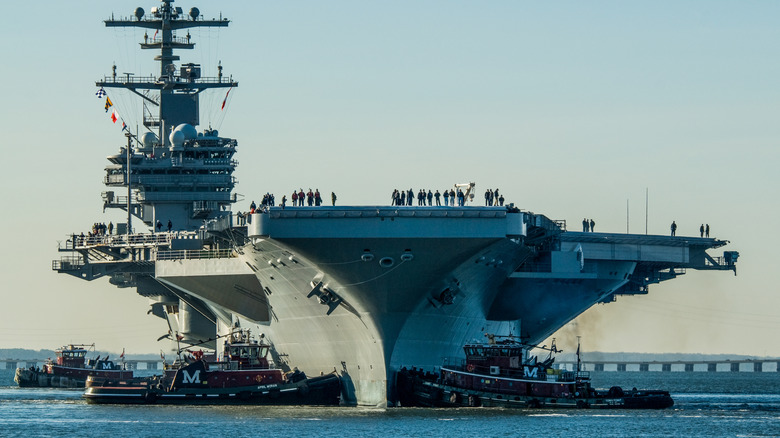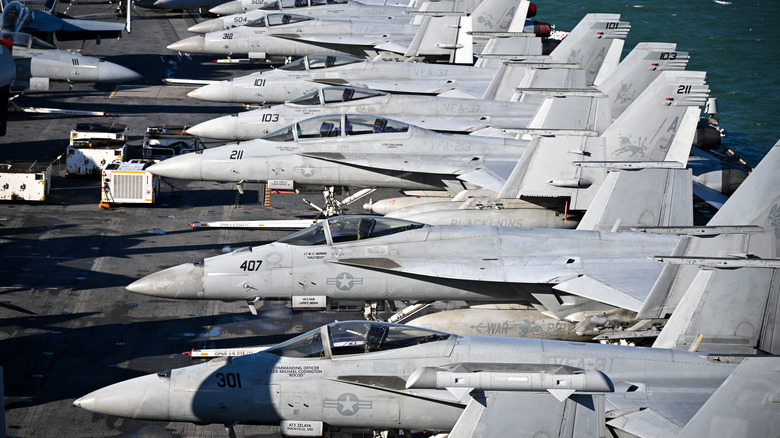How Many Fighter Jets Can A US Aircraft Carrier Hold?
Aircraft carriers are the largest and most technologically advanced weapons of war. While they're impressive naval vessels, they're also mobile airports, and without an aircraft carrier's large number of support jets and helicopters, it's little more than a floating island (though it does have defensive capabilities). A carrier's strength lies in its aircraft, but modern carriers don't simply throw as many planes onto a vessel as possible and call it a day — a lot of engineering goes into determining the right number of aircraft a carrier can hold.
While aircraft carriers can hold everything from cargo planes to helicopters, they're best known for housing fighter jets, and the United States has a bunch of them. Presently, the U.S. has 11 active aircraft carriers and Carrier Strike Groups, and more are on the way. Over the years, the U.S. has upgraded and modified its carrier fleet, beginning with rudimentary carriers in WWI and moving to more advanced classes in WWII. Modern carriers are vastly different, as they're considerably larger and significantly more technologically advanced.
The United States' 11 carriers aren't the same class, as the fleet replaces older carriers as new ones are commissioned. Currently, the U.S. operates ten Nimitz-class carriers and one Gerald R. Ford-class carrier. Eventually, the fleet of Nimitz carriers will retire, and new Ford-class carriers will take their place. The USS Enterprise is currently under construction and is expected to enter service around 2030. How many fighter jets fit on an aircraft carrier? Each class carries a different number of jets, numbering from around 50-90, depending on configuration.
Fighter jets on a Nimitz-class carrier
The USS Nimitz is the first in its class and oldest carrier in the fleet, having been commissioned in 1975. The last Nimitz-class ship, the USS George H.W. Bush (CVN-77), entered service in 2009, and it featured numerous upgrades and modernization over its predecessors in the fleet. The massive vessel is crewed by some 6,000 sailors and marines and over 2,400 personnel in its air wing. In total, the Bush can carry 90 aircraft, but not all of them are fighter jets, and it doesn't always carry that many.
USS George H.W. Bush typically carries 56 fighter jets, including the F/A-18A/C and F/A-18E/F Super Hornets. The carrier has four steam catapults and three arrestor cables, enabling flight operations to put a bird in the sky every 20 seconds for a total of 140 sorties a day. CVN-77 supports other fixed-wing aircraft like the EA-6B Prowler and E-2C Hawkeye, as well as numerous types of drones and helicopters like the SH-60F, HH-60H, and SH-60B Seahawk.
Different configurations are possible, and the vessel could technically carry more jets. The number it typically operates with is ideal for operations and has a proven track record on the Bush and other Nimitz-class vessels. Nimitz-class carriers have a 50-year service life, so many are nearing the end of their time at sea to make way for the newer, larger, and more advanced Gerald R. Ford-class aircraft carriers.
Fighter jets on a Ford-class carrier
So far, only the USS Gerald R. Ford has been placed into service, though several are currently under construction. These new vessels are the largest warships ever created, and they boast numerous impressive offensive and defensive capabilities. A Ford-class carrier hosts around 4,660 personnel that make up its ship, air wing, and staff. The Ford was commissioned in 2017 and stands as the most technologically advanced supercarrier ever constructed.
A Ford-class carrier can accommodate a variety of aircraft, including fixed-wing jets, helicopters, and drones. Typically, a Ford-class carrier can support 75 aircraft, a large portion of which are fighter jets. The carrier is capable of holding more than 90 aircraft, but this isn't standard operating procedure. The USS Ford carries more advanced fighter jets, including the F-35C Lightning II, but it also hosts F/A-18A/C and F/A-18E/F Super Hornets like Nimitz-class ships.
The Ford is bigger, but it's also faster, thanks to its electromagnetic aircraft launch system, EMALS. The Ford can fly 160 sorties each day, making it faster and more combat-capable than its predecessors. The advantages of the Ford-class carrier over the Nimitz-class are its speed and efficiency, but more than that, the use of EMALS over a steam catapult ensures fewer moving parts, less space required, faster operation, and significantly less maintenance. All of this comes together with a large fleet of attack aircraft, enabling the U.S. to spread its military might anywhere in the world.


